
Original Link: https://www.anandtech.com/show/2104
ATI Radeon X1950 Pro: CrossFire Done Right
by Derek Wilson on October 17, 2006 6:22 AM EST- Posted in
- GPUs
Introduction
It seems that ATI has been releasing a constant stream of new or rebadged graphics cards lately, and it looks like this month won't be any different. Today is quite a special treat: ATI has integrated new CrossFire specific features onto the GPU itself. The release of another part at the $200 price point after ATI's recent price drops and re-badging would otherwise seem redundant, but the advantages of the changes ATI has made to CrossFire really bolster its ability to compete with NVIDIA's SLI.
The new Radeon X1950 Pro is a pretty heavy hitter at $200, bringing slightly faster than the current X1900 GT performance to a slightly lower price point. With the X1900 GT currently being phased out, we would expect nothing less. This will certainly help strengthen ATI's ability to compete with the 7900 GS at the $200 price point, and might even make the X1950 Pro a viable option over some more expensive overclocked 7900 GS parts.
In spite of the fact that ATI is using TSMC's 80nm process, we don't expect to see very many overclocked versions of the X1950 Pro, as the high transistor count, large die size and high speeds tend to get in the way of stable overclocking. We will certainly be testing out the overclocking capabilities of the X1950 Pro when we get our hands on some retail versions of the cards (overclocking with reference cards doesn't always give an accurate picture of the products capabilities). For now, we'll just have to wait and see. In the mean time, we've got plenty of other things to explore.
For this look at ATI's newest graphics card, we'll take a peek at the details of the RV570 hardware, what differences have been introduced into CrossFire with the new silicon, and performance of single and multi-GPU configurations from the midrange through the high end. We will find out if the X1950 Pro is really a viable replacement for the X1900 GT, and whether or not the enhancements to CrossFire are enough to bring ATI on to the same playing field as NVIDIA.
RV570 and the Demise of the X1900 GT
The silicon used in the X1950 Pro is based on an 8-vertex 36-pixel shader configuration. While the X1900 GT has the same pipeline configuration as the X1950 Pro, the X1900 GT is based on R580 cores with disabled or non-functional pipelines. The RV570 core is built with the X1950 Pro in mind. With the introduction of the X1950 Pro, the X1900 GT will be phased out. It is unclear whether or not ATI has a use planned for R580+ GPUs that don't make the cut on the high end, but it looks like they won't just fall neatly into the X1900 GT. We would like to say that the X1950 Pro has the same core clock speed as the X1900 GT, but the issue is a little more complicated.
The X1900 GT will be going through a slight revision before its disappearance. Due to a shortage of original R580 cores that can clock to 575MHz, ATI is dropping the specs on the X1900 GT to 512MHz while attempting to make up for this by boosting memory speed to 1320MHz from 1200MHz. This is being done to keep the supply of X1900 GT parts steady until the X1950 Pro is able to take over. It is difficult to describe just how inappropriate it is to retard the specs on a long shipping product in this manner.
It is hard enough for us to sort things out when parts hit the shelves at different speeds than originally promised, but to do something like this after a part has been on the market for months is quite astounding. Be very careful when looking at buying an X1900 GT over the next couple months. The safest route is to avoid the X1900 GT altogether and simply let the X1950 Pro act as an immediate replacement for the X1900 GT. Leaving 512MHz product sitting on shelves is the best way to send the message that this type of action is not to be taken again. For our part, we have to express our extreme disappointment in ATI for taking this route. We certainly understand that it is difficult to make decisions about what to do when faced with product shortages, but we would like to strongly urge everyone in the computing industry to avoid doing anything like this to stretch the life of a product.
For now, let's get back to the X1950 Pro. Weighing in at about 330 million transistors and about 230 mm2, the RV570 is no small GPU. In addition to the features listed below, RV570 includes an integrated compositing engine for what ATI calls "native" CrossFire support which we'll explain shortly. The heatsink has a different look to match the rest of the X1950 family in a single slot solution. There are also the new CrossFire connectors in nearly the same position as the NVIDIA SLI bridge position. Here are some pictures and tables to help illustrate.

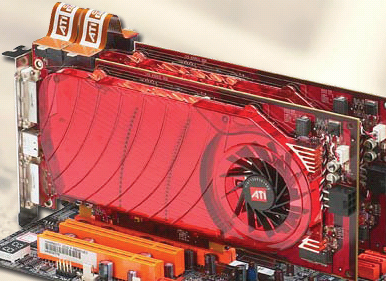
| NVIDIA Graphics Card Specifications | ||||||||
|
Vert Pipes
|
Pixel Pipes
|
Raster Pipes
|
Core Clock
|
Mem Clock
|
Mem Size (MB)
|
Mem Bus (bits)
|
Price
|
|
| GeForce 7950 GX2 |
8x2
|
24x2
|
16x2
|
500x2
|
600x2
|
512x2
|
256x2
|
$600
|
| GeForce 7900 GTX |
8
|
24
|
16
|
650
|
800
|
512
|
256
|
$450
|
| GeForce 7950 GT |
8
|
24
|
16
|
550
|
700
|
512
|
256
|
$300-$350
|
| GeForce 7900 GT |
8
|
24
|
16
|
450
|
660
|
256
|
256
|
$280
|
| GeForce 7900 GS |
7
|
20
|
16
|
450
|
660
|
256
|
256
|
$200-$250
|
| GeForce 7600 GT |
5
|
12
|
8
|
560
|
700
|
256
|
128
|
$160
|
| GeForce 7600 GS |
5
|
12
|
8
|
400
|
400
|
256
|
128
|
$120
|
| GeForce 7300 GT |
4
|
8
|
2
|
350
|
667
|
128
|
128
|
$100
|
| GeForce 7300 GS |
3
|
4
|
2
|
550
|
400
|
128
|
64
|
$65
|
| ATI Graphics Card Specifications | ||||||||
|
Vert Pipes
|
Pixel Pipes
|
Raster Pipes
|
Core Clock
|
Mem Clock
|
Mem Size (MB)
|
Mem Bus (bits)
|
Price
|
|
| Radeon X1950 XTX |
8
|
48
|
16
|
650
|
1000
|
512
|
256
|
$450
|
| Radeon X1900 XTX |
8
|
48
|
16
|
650
|
775
|
512
|
256
|
$375
|
| Radeon X1900 XT |
8
|
48
|
16
|
625
|
725
|
256/512
|
256
|
$280/$350
|
| Radeon X1950 Pro |
8 |
36 |
12 |
575 |
690 |
256 |
256 |
$200 |
| Radeon X1900 GT |
8
|
36
|
12
|
575
|
600
|
256
|
256
|
$220
|
| Radeon X1650 Pro |
5
|
12
|
4
|
600
|
700
|
256
|
128
|
$99
|
| Radeon X1600 XT |
5
|
12
|
4
|
590
|
690
|
256
|
128
|
$150
|
| Radeon X1600 Pro |
5
|
12
|
4
|
500
|
400
|
256
|
128
|
$100
|
| Radeon X1300 XT |
5
|
12
|
4
|
500
|
400
|
256
|
128
|
$89
|
| Radeon X1300 Pro |
2
|
4
|
4
|
450
|
250
|
256
|
128
|
$79
|
The New Face of CrossFire
There haven't been any changes to the way CrossFire works from an internal technical standpoint, but a handful of changes have totally revolutionized the way end users see CrossFire. NVIDIA's SLI approach has always been fundamentally better from an end user standpoint. Internal connectors are cleaner and easier to use than ATI's external dongle, and the ability to use any X1950 Pro in combination with any other X1950 Pro is absolutely more desirable than the dedicated master card approach. ATI has finally done it right and followed in NVIDIA's footsteps.
At the heart of the changes to CrossFire is the movement of ATI's compositing engine from the card onto the GPU itself. This does add cost to every GPU and thus every graphics card, but the added benefits far out weigh any negatives. In early versions of CrossFire, digital pixel information was sent between cards using TMDS transmitters (the same transmitters used to send display information over DVI and HDMI). While this format is fine for displays, it isn't as well suited for chip to chip communication.
With the compositing engine built into every GPU, ATI is now able to send pixel data through an over-the-top NVIDIA style bridge directly to another GPU. This also eliminates the necessity of a TMDS link for use in transmitting pixel data. ATI hasn't talked about what type of communication protocol is used between the compositing engines on each chip, but we suspect that it is a little lower speed than NVIDIA's 1GHz connection. ATI is using a higher bit-width connection split into 2 12-bit parallel channels. At full capacity, ATI states that these connections can support resolutions of up to 2560x2048, but that communication doesn't happen any faster than the old style TMDS method.
ATI did make it clear that even though this incarnation of CrossFire supports a higher resolution than we are currently able to test, it won't necessarily run well. Of course, we'd much rather see a situation where we aren't limited by some technical aspect of the hardware. The first incarnation of CrossFire was quite disappointing due to its low maximum resolution of 1600x1200.
One of the oddities of this multi-GPU implementation is the splitting up of the connector that links the GPUs. Both are required for the driver to enable CrossFire, but only one is technically necessary. As bridges will be bundled with graphics cards, everyone who purchases 2 X1950 Pro cards will have two bridges. This eliminates the need for end users to buy bridges separately or rely on them shipping with their multi-GPU motherboard. When pressed further about why two connectors were used, ATI asked us to envision a system with 3 or 4 graphics cards installed. With 2 channels, cards can be easily chained together. This does offer ATI a little more flexibility than NVIDIA in scaling multi-GPU configurations, but it is also a little more cumbersome and offers more small parts to lose. Overall, though, the 2 channel configuration is a good thing.
Now that we have a chip built specifically for the $200 price point with a robust, full featured, CrossFire implementation, we are very interested in seeing what type of performance ATI is offering.
The Test
We are using the same Intel Core 2 Extreme X6800 setup for this article that we've been using over the past couple months. Driver revisions haven't changed since our 7950 GT article, and we will be looking at the same three resolutions: 1280x1024, 1600x1200 and 1920x1440. Here's the breakdown of the hardware used:
| CPU: | Intel Core 2 Extreme X6800 (2.93GHz/4MB) |
| Motherboard: |
Intel D975XBX (LGA-775) ASUS P5NSLI |
| Chipset: |
Intel 975X NVIDIA nForce 570 SLI |
| Chipset Drivers: |
Intel 7.2.2.1007 (Intel) NVIDIA nForce 8.22 |
| Hard Disk: | Seagate 7200.7 160GB SATA |
| Memory: | Corsair XMS2 DDR2-800 4-4-4-12 (1GB x 2) |
| Video Card: | Various |
| Video Drivers: |
ATI Catalyst 6.9 NVIDIA ForceWare 91.47 |
| Desktop Resolution: | 1920 x 1440 - 32-bit @ 60Hz |
| OS: | Windows XP Professional SP2 |
We will also be testing with the same seven games we've employed for the past few reviews. Next month will see an exciting change in our benchmarking lineup as we are preparing new games for the bench right now. Expect to see the latest Battlefield, Splinter Cell, and Company of Heroes make their way into our test suite in the near future. For now, sit back, relax, and enjoy the soothing experience that is benchmark analysis.
There is quite a bit of data in each of these tests, so we'll focus on the sweet-spot performance analysis and leave the rest of the data more for reference than anything else.
Battlefield 2 Performance
This benchmark is performed using DICE's built in demo playback functionality
with a few added extras built in house. When using the built in demo playback
features of BF2, frames rendered during the loading screen are counted in the
benchmark. In order to get a real idea of performance, we use the
instantaneous frametime and frames per second data generated from a benchmark
run. We discard the data collected during the loading screen and calculate a
result that represents the actual gameplay that was benchmarked. While DICE
maintains that results over 100fps aren't reliable, our methods have allowed
us to get useful data from high performing systems.
During the benchmark, the camera switches between players and vehicles in
order to capture the most action possible. There is a lot of smoke and
explosions, so this is a very GPU intensive Battlefield 2 benchmark. The game
itself is best experienced with average in-game framerates of 35 and up.
We ran Battlefield 2 using the highest quality graphics settings we could.
Shadows, lighting, and especially view distance are very important in order to
best play the game. In our opinion view distance should never be set to less
than the max, but other settings can be decreased slightly if a little more
performance or a higher resolution is required.
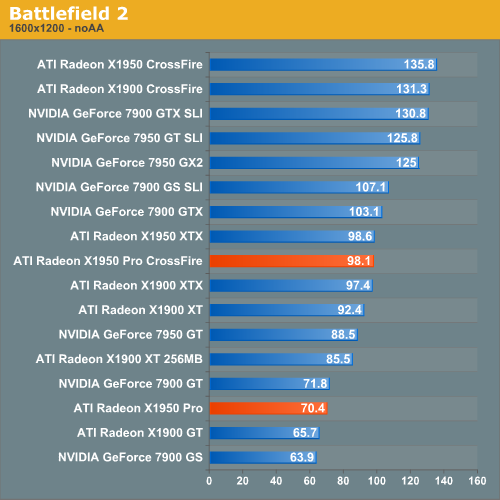
Its ability to offer 7900 GT levels of performance at the price of a 7900 GS makes the Radeon X1950 Pro quite a deal. The added memory speed gives the X1950 Pro a good advantage over the X1900 GT here. Of course, when the new handicapped X1900 GT comes along, expect this gap to widen. X1950 Pro CrossFire offers performance levels on par with X1900/X1950 XTX under BF2 without AA enabled. This puts it in competition with the 7900 GTX and offers much better performance than the 7950 GT. All what we would expect from $400 of graphics card. Interestingly, NVIDIA's 7900 GS SLI is able to offer better performance than X1950 Pro CrossFire in spite of the single card performance advantage the later maintains. This indicates that SLI scales much better than CrossFire under these conditions.
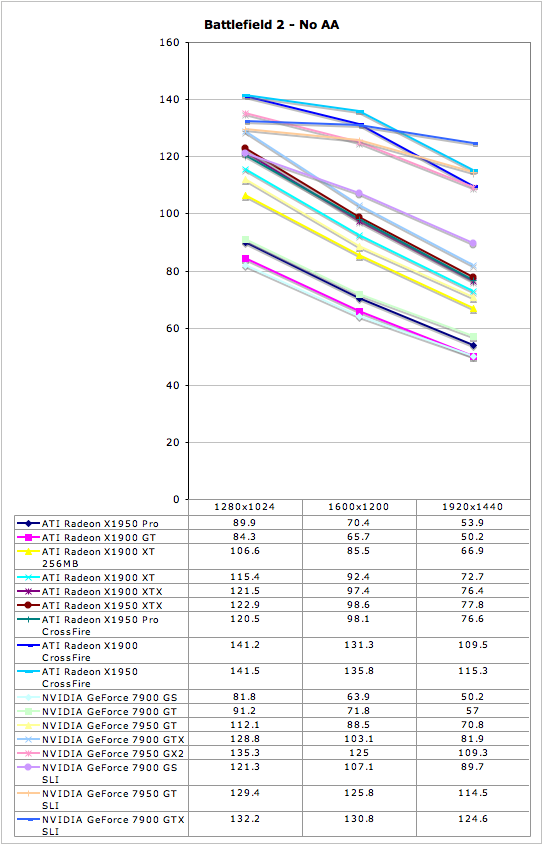
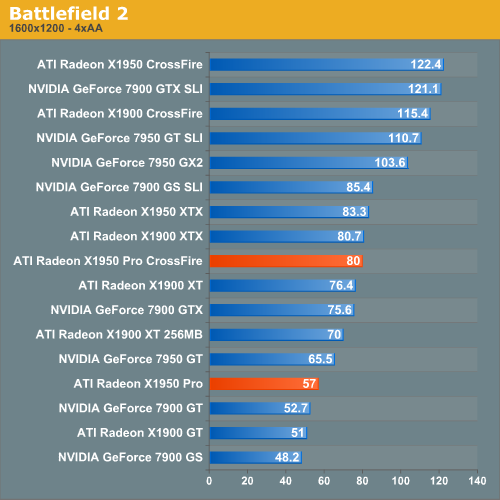
With 4xAA enabled, the X1950 Pro performs even better compared to the competition. CrossFire, however, doesn't give any more of a boost in comparison to X1900/X1950 XTX or 7900 GS SLI than we saw without AA. The X1950 Pro is an excellent choice as a single card solution, but for multi-GPU users, SLI is still a better bet.
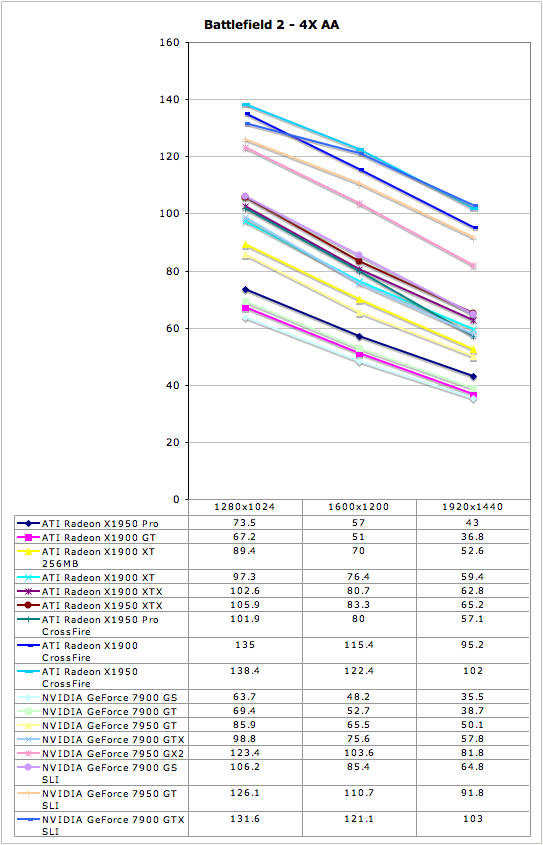
Black & White 2 Performance
The AnandTech benchmark for Black & White 2 is a FRAPS benchmark. Between
the very first tutorial land and the second land there is a pretty well
rounded cut scene rendered in-game. This benchmark is indicative of real world
performance in Black & White 2. We are able to see many of the commonly
rendered objects in action. The most stressful part of the benchmark is a
scene where hundreds of soldiers come running over a hill, which really pounds
the geometry capabilities of these cards. At launch, ATI cards were severely
outmatched when it came to B&W2 performance because of this scene, but two
patches applied to the game and quite a few Catalyst revisions later give ATI
cards a much needed boost in performance over what we first saw.
A desirable average framerate for Black & White 2 is anything over 20 fps.
The game does remain playable down to the 17-19 fps range, but we usually
start seeing the occasional annoying hiccup during gameplay here. While this
isn't always a problem as far as getting things done and playing the game, any
jerkiness in frame rate degrades the overall experience.
We did test with all the options on the highest quality settings under the
custom menu. Antialiasing has quite a high performance hit in this game, and
is generally not worth it at high resolutions unless the game is running on a
super powerhouse of a graphics card. If you're the kind of person who just
must have AA enabled, you'll have to settle for a little bit lower resolution
than we tend to like on reasonably priced graphics cards. Black & White 2
is almost not worth playing at low resolutions without AA, depth of field, or
bloom enabled. At that point, we tend to get image quality that resembles the
original Black & White. While various people believe that the original was
a better game, no one doubts the superiority of B&W2's amazing
graphics.

As with Battlefield 2, we see performance on par with the 7900 GT. In this case, the X1950 Pro actually equals the performance of the X1900 XT 256MB. It seems like either geometry or memory (or both) are the major factors in performance here. Again, CrossFire offers a good boost over single card performance exceeding the high end single card solutions from both manufacturers, but 7900 GS SLI still comes back from behind in the singe card race to beat CrossFire.
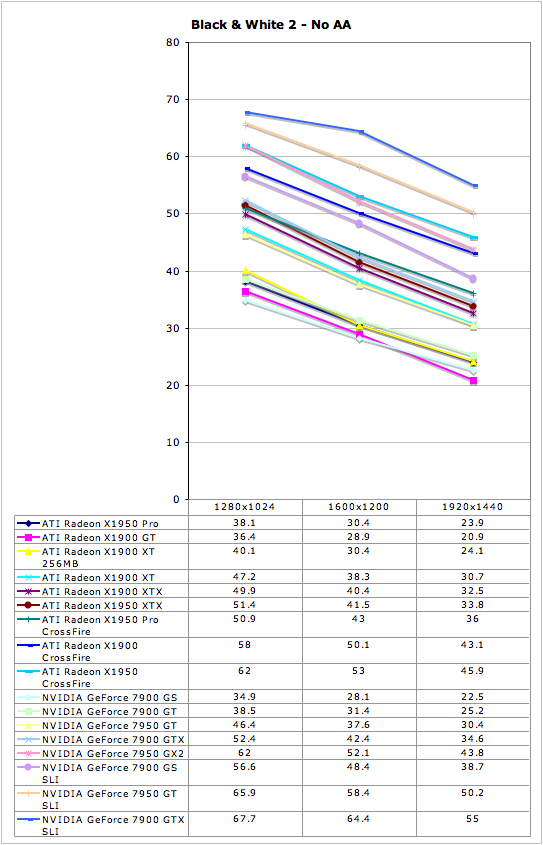
The Elder Scrolls IV: Oblivion Performance
While it is disappointing that Oblivion doesn't have a built in benchmark, our
FRAPS tests have proved to be fairly repeatable and very intensive on every
part of a system. While these numbers will reflect real world playability of
the game, please remember that our test system uses the fastest processor we
could get our hands on. If a purchasing decision is to be made using Oblivion
performance alone, please check out our two articles on the
CPU
and
GPU
performance of Oblivion. We have used the most graphically intensive benchmark
in our suite, but the rest of the platform will make a difference. We can
still easily demonstrate which graphics card is best for Oblivion even if our
numbers don't translate to what our readers will see on their systems.
Running through the forest towards an Oblivion gate while fireballs fly by our
head is a very graphically taxing benchmark. In order to run this benchmark,
we have a saved game that we load and run through with FRAPS. To start the
benchmark, we hit "q" which just runs forward, and start and stop FRAPS at
predetermined points in the run. While not 100% identical each run, our
benchmark scores are usually fairly close. We run the benchmark a couple times
just to be sure there wasn't a one time hiccup.
As for settings, we tested a few different configurations and decided on this
group of options:
| Oblivion Performance Settings | |
| Texture Size | Large |
| Tree Fade | 100% |
| Actor Fade | 100% |
| Item Fade | 66% |
| Object Fade | 90% |
| Grass Distance | 50% |
| View Distance | 100% |
| Distant Land | On |
| Distant Buildings | On |
| Distant Trees | On |
| Interior Shadows | 95% |
| Exterior Shadows | 85% |
| Self Shadows | On |
| Shadows on Grass | On |
| Tree Canopy Shadows | On |
| Shadow Filtering | High |
| Specular Distance | 100% |
| HDR Lighting | On |
| Bloom Lighting | Off |
| Water Detail | High |
| Water Reflections | On |
| Water Ripples | On |
| Window Reflections | On |
| Blood Decals | High |
| Anti-aliasing | Off |
Our goal was to get acceptable performance levels under the current generation
of cards at 1600x1200. This was fairly easy with the range of cards we tested
here. These settings are amazing and very enjoyable. While more is better in
this game, no current computer will give you everything at high res. Only the
best multi-GPU solutions and a great CPU are going to give you settings like
the ones we have at high resolutions, but who cares about grass distance,
right?
While Oblivion is very graphically intensive and is played mostly from a first
person perspective (and some third person), this definitely isn't a twitch
shooter. Our experience leads us to conclude that 20fps gives a good
experience. It's playable a little lower, but watch out for some jerkiness
that may pop up. Getting down to 16fps and below is a little too low to be
acceptable. The main point to bring home is that you really want as much eye
candy as possible. While Oblivion is an immersive and awesome game from a
gameplay standpoint, the graphics certainly help draw the gamer
in.

Oblivion finally shows an advantage for CrossFire as compared to SLI at the $200 card pricepoint. It still looks like SLI scales better over all (i.e. 7900 GS SLI is 88% faster than a single card, while X1950 Pro CF is only 66% faster than a single X1950 Pro), but this time even double the performance of a single 7900 GS card wouldn't be enough to beat the X1950 Pro CrossFire. We see the X1900 GT, X1950 Pro and X1900 XT 256MB all clustered together here in a rather unexpected order, but the variance of our oblivion benchmark is the culprit here. We can say that these cards all perform about the same under Oblivion, but pinning it down more than that isn't easy. No matter how we slice it though, ATI owns this benchmark.

F.E.A.R. Performance
F.E.A.R. has a built in test that we make use of in this performance analysis.
This test flies through some action as people shoot each other and things blow
up. F.E.A.R. is very heavy on the graphics, and we enable most of the high end
settings for our test.
During our testing of F.E.A.R., we noted that the "soft shadows" don't really
look soft. They jumped out at us as multiple transparent shadows layered on
top of each other and jittered to appear soft. Unfortunately, this costs a lot
in performance and not nearly enough shadows are used to make this look
realistic. Thus, we disable soft shadows in our test even though it's one of
the large performance drains on the system.
Again we tested with anisotropic filtering at 8x, and all options were on
their highest quality (with the exception of soft shadows which was disabled).
Frame rates for F.E.A.R. can get pretty low for a first person shooter, but
the game does a good job of staying playable down to about 25 fps.
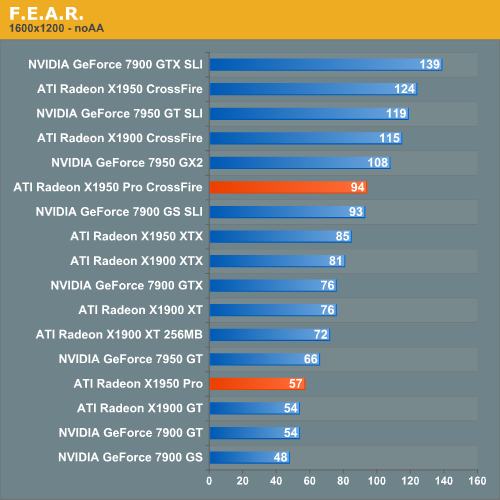
The $400 SLI/CrossFire solutions from NVIDIA and ATI essentially tie each other under F.E.A.R. This does mean that SLI once again scales better than CrossFire, but the X1950 Pro maintains its performance advantage.

Half-Life 2: Episode One Performance
Episode One of the new Half-Life 2 series makes use of recent Source engine
updates to include Valve's HDR technology. While some people have done HDR
that won't allow antialiasing (even on ATI cards), Valve put a high value on
building an HDR implementation that everyone can use with whatever settings
they want. Consistency of experience is usually not important enough to
developers who care about pushing the bleeding edge of technology, so we are
very happy to see Valve going down this path.
We use the built-in timedemo feature to benchmark the game. Our timedemo
consists of a protracted rocket launcher fight and features much debris and
pyrotechnics. The Source engine timedemo feature is more like the nettimedemo
of Id's Doom 3 engine, in that it plays back more than just the graphics. In
fact, Valve includes some fairly intensive diagnostic tools that will reveal
almost everything about every object in a scene. We haven't found a good use
for this in the context of reviewing computer hardware, but our options are
always open.
The highest visual quality settings possible were used including the "reflect
all" setting which is normally not enabled by default, and anisotropic
filtering was set at 8x. While the Source engine is notorious for giving great
framerates for almost any hardware setup, we find the game isn't as enjoyable
if it isn't running at at least 30fps. This is very attainable even at the
highest resolution we tested on most cards, and thus our target framerate is a
little higher in this game than others.
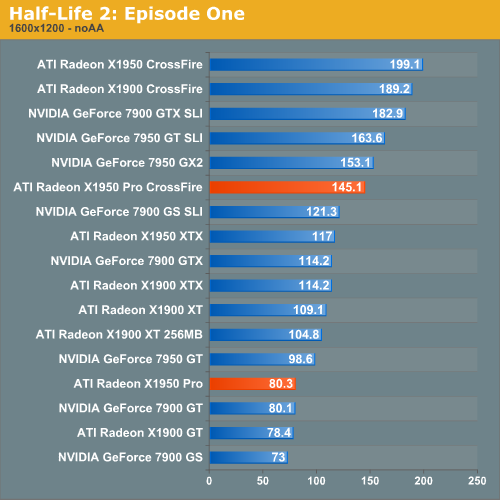
Showing about a 10% performance advantage over the 7900 GS, the X1950 Pro delivers a good level of performance under Half-Life 2: Episode One without AA enabled. Combine that with the fact that CrossFire delivers about an 80% performance improvement to SLI's 66%, and we have a clear winner in the mulit-GPU department here.
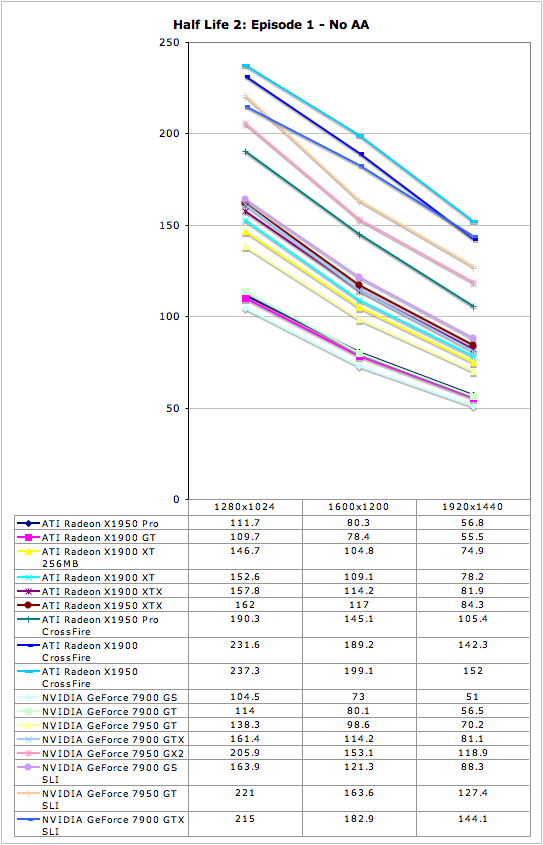
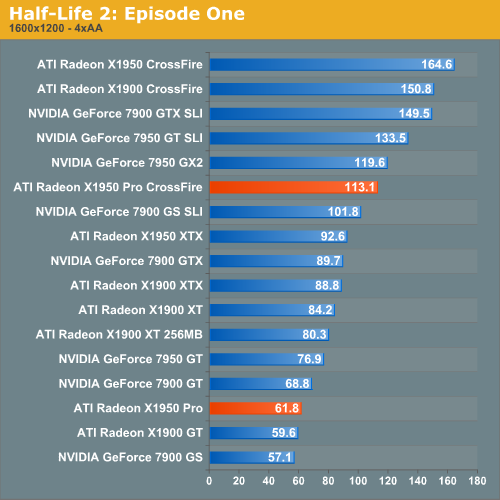
Enabling 4xAA under HL2:EP1 closes the gap between ATI and NVIDIA at the $200
mark, but still leaves ATI in the lead. The same is true in the multi-GPU
arena.
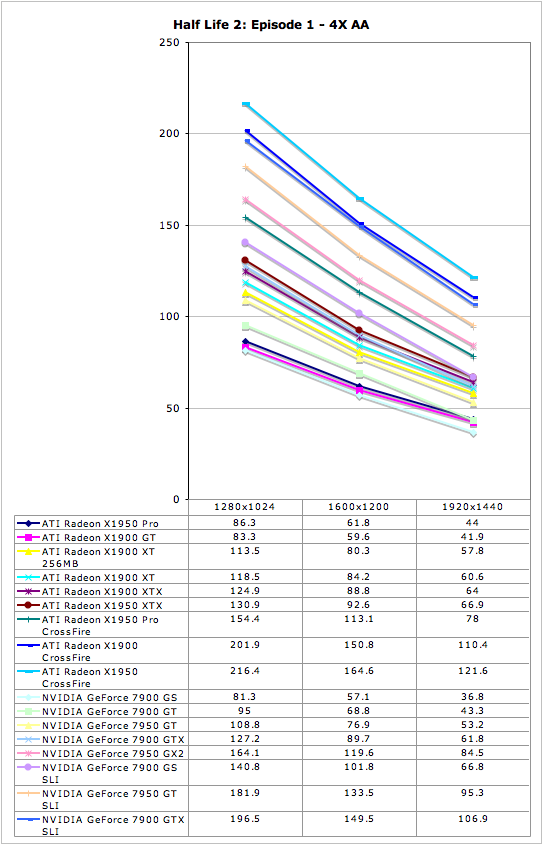
Quake 4 Performance
There has always been a lot of debate in the community surrounding pure
timedemo benchmarking. We have opted to stick with the timedemo test rather
than the nettimedemo option for benchmarking Quake 4. To be clear, this means
our test results focus mostly on the capability of each graphics card to
render frames generated by Quake 4. The frame rates we see here don't directly
translate into what one would experience during game play.
Additionally, Quake 4 limits frame rate to 60 fps during gameplay whether or
not VSync is enabled. Performance characteristics of a timedemo do not reflect
actual gameplay. So why do we do them? Because the questions we are trying to
answer have only to do with the graphics subsystem. We want to know what
graphics card is better at rendering Quake 4 frames. Any graphics card that
does better at rendering Quake 4 frames will handle Quake 4 better than
another card. While that doesn't mean the end user will necessarily see higher
performance throughout the game, it does mean that the potential for seeing
more performance is there. For instance, if the user upgrades CPUs while
keeping the same graphics card, having higher potential GPU performance is
going to be important.
What this means to the end user is that in-game performance will almost always
be lower than timedemo performance. It also means that graphics cards that do
slightly better than other graphics cards will not always show a tangible
performance increase on an end user's system. As long as we keep these things
in mind, we can make informed conclusions based on the data we collect.
Our benchmark consists of the first few minutes of the first level. This
includes both inside and outdoor sections, with the initial few fire fights.
We tested the game with Ultra Quality settings (uncompressed normal maps), and
we enabled all the advanced graphics options except for VSync. Id does a
pretty good job of keeping framerate very consistent, and so in-game
framerates of 25 are acceptable. While we don't have the ability to make a
direct mapping to what that means in the timedemo test, our experience
indicates that a timedemo fps of about 35 translates into an enjoyable
experience on our system. This will certainly vary on other systems, so take
it with a grain of salt. The important thing to remember is that this is more
of a test of relative performance of graphics cards when it comes to rendering
Quake 4 frames -- it doesn't directly translate to Quake 4 experience.
Before we get to performance analysis here, we must note that ATI has confirmed our numbers and indicated that Quake 4 performance with X1950 Pro CrossFire suffers from a driver issue that will be resolved in an upcoming version of Catalyst drivers.
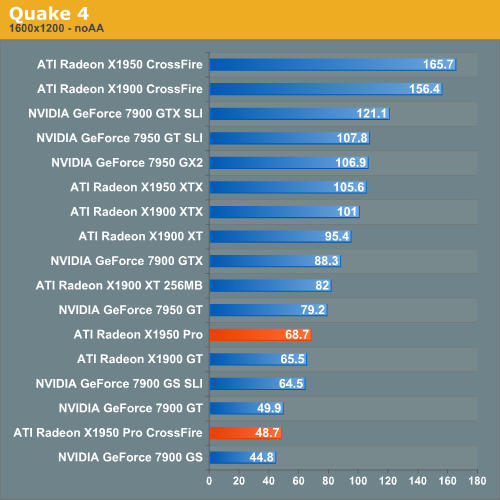
A single 7900 GS loses quite handily to the X1950 Pro under Quake 4 without AA enabled. We won't be able to talk about X1950 Pro CrossFire performance until ATI fixes the current driver issue. For now, we do see proper scaling under Quake 4 with High Quality mode enabled rather than Ultra Quality.

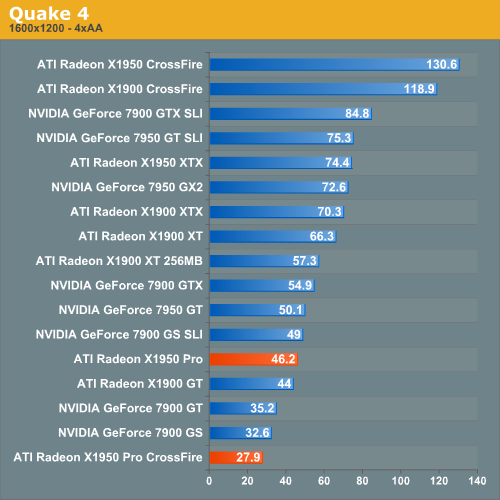
Performance characteristics with 4xAA enabled are similar to those without AA.
The 7900 GS does close the gap a little with the X1950 Pro, but it isn't
nearly enough to put them in the same category.
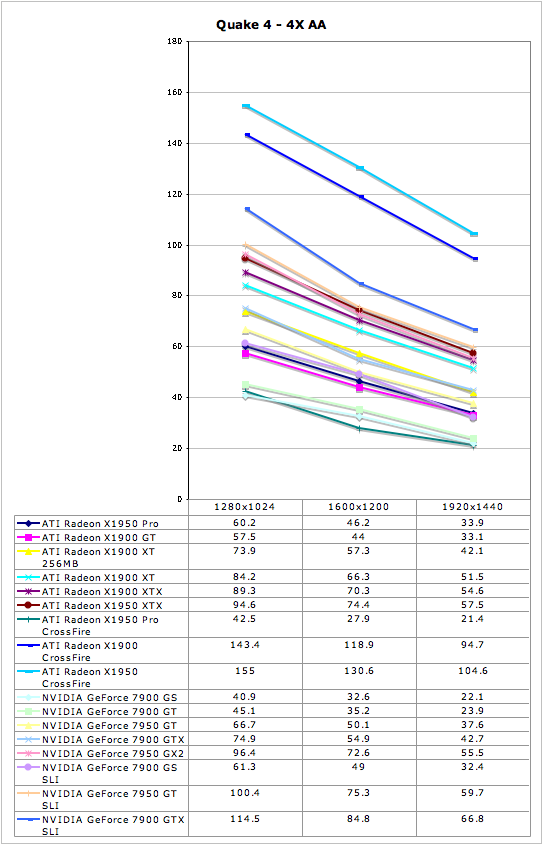
Splinter Cell: Chaos Theory Performance
We make use of the Lighthouse demo for Splinter Cell: Chaos Theory. We have
been using this benchmark for quite some time and facilitate automation with
the scripts published at Beyond 3D. This benchmark is fairly close to in game
performance for our system, but midrange users may see a little lower real
world performance when tested with a lower speed processor.
Our settings all used the highest quality level possible including the extra
SM3.0 features. As the advanced shaders and antialiasing are mutually
exclusive under SC:CT, we left AA disabled and focused on the former. We set
anisotropic filtering to 8x for all cards.
For this 3rd person stealth game, ultra high frame rates are not necessary. We
have a good playing experience at 25 fps or higher. There may be the framerate
junkie out there who likes it a little higher, but our recommendation is based
on consistency of experience and ability to play the game without a degraded
experience.
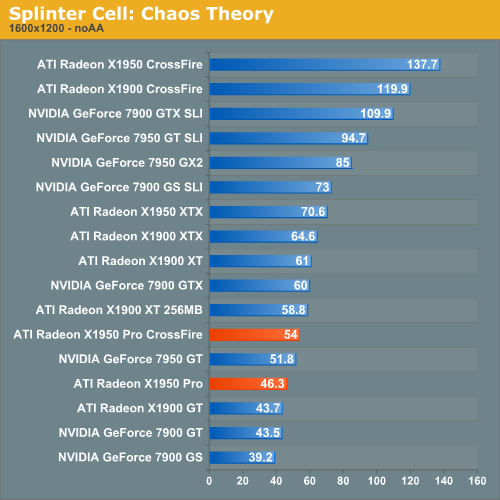
Once again, ATI has informed us that we should expect to see higher X1950 Pro CrossFire numbers in a future driver release. With other CrossFire configurations as a guide, we can easily expect X1950 Pro to nearly double its single card performance and put it on par with the 7950 GX2 and 7900 GT SLI configurations. As for single card performance, we see the trend of X1950 Pro domination continuing. Performance greater than that of the 7900 GS and GT for $200 is hard to argue with.

Power
The current generation of ATI GPUs have been very power hungry. With much higher transistor counts and larger die sizes than competing NVIDIA products, ATI has lagged behind NVIDIA for quite some time in the area of performance per watt. The trade off has been that ATI's parts are more feature complete than NVIDIA's. The price for full time 32bit processing in pixel shaders, angle independent anisotropic filtering, antialiasing of floating point textures, and fine grained branching must be paid somehow. A more power hungry, hotter running chip is certainly a fine trade off to get the performance ATI is capable of delivering.
But with the RV570 that powers the X1950 Pro, we expect to see a little better power consumption. Additional transistors are used for the integrated CrossFire compositing engine, but with fewer pixel shaders and a smaller fab process the X1950 Pro comes in much smaller. R580 weighs in at 384 Million transistors with a 352mm2 die size, while the RV570 GPU is 330 Million transistors and 230mm2. What does all of this translate to in terms of power? Let's take a look.


While the X1950 Pro does show a drop in power from the X1900 GT, the decrease isn't huge. Part of this is due to the fact that the X1950 Pro uses faster memory than the X1900 GT (1380MHz as opposed to 1200MHz). Taking the fact that the X1950 Pro is also higher performance than the X1900 GT, we can certainly be happy with what ATI has delivered. Compared to the 7900 GS, the X1950 Pro is higher performance, but also higher power. We'll have to wait until we see an 80nm high end part to see if there will be a decrease in power where it is needed most.
The fan used isn't really louder than the X1900 GT, but the aural quality isn't as desirable in our opinion. The new fan on the X1950 Pro is a little higher pitched and whiny. We would also love to see the 4-pin fan control employed on the rest of the X1950 series here as well, but the control is more important on a larger fan anyway.
Final Words
We will have to wait until later today to confirm availability, but ATI has made it clear that this is supposed to be a hard launch. And we certainly hope they deliver on their promise and get those X1950 Pro cards on shelves before people start buying handicapped X1900 GT cards.
All in all, the X1950 Pro is the performance leader at the $200 mark. We heartily recommend it for any gamer with a couple c-notes to drop on graphics hardware. This card is an excellent replacement to the original X1900 GT in both performance, price, and CrossFire capability. While 80nm doesn't deliver huge power savings, RV570 does offer ATI quite an advantage in terms of die size and cost in the long run. We haven't yet tested overclocking with this new core, but we will certainly address the issue once we get our hands on shipping product.
The changes to CrossFire offer quite a bit of value to the end user. The bridge solution is much easier to work with than the external dongle, and while the 2 bridge solution is a little more cumbersome than a single bridge as with SLI, we can't argue with ATI's bridge distribution method or the fact that a 2 channel over the top connection offers greater flexibility in a more than 2 card multi-GPU solution. We also like the fact that ATI is distributing only flexible bridges as opposed to the more common PCB style bridges we often see on SLI systems.
From a technical standpoint, SLI still has the upper hand over CrossFire in terms of scalability and performance in most cases. Over time, we hope to see ATI increasing their scalability in games across the board, but, until we see ATI take a new approach to inter-GPU communication, SLI looks like it will maintain the lead for the foreseeable future. Hopefully ATI has some new approaches lined up for its upcoming R600 that will put CrossFire truly on par with NVIDIA's SLI.
As much as we would like to end this review of a solid product on a high note, we've got to drive home the point that significantly decreasing the specs of a product after it ships is simply not acceptable. The fact that ATI would drop the core clock speed of the X1900 GT by 11% and raise the memory clock by 10% to try to hide the difference is not something we want to see happen. There will be a performance difference between the new and old parts, and not changing the name on the box is simply dishonest. At least ATI has delivered a solid product in the X1950 Pro. Hopefully it'll stay that way throughout its life cycle.







